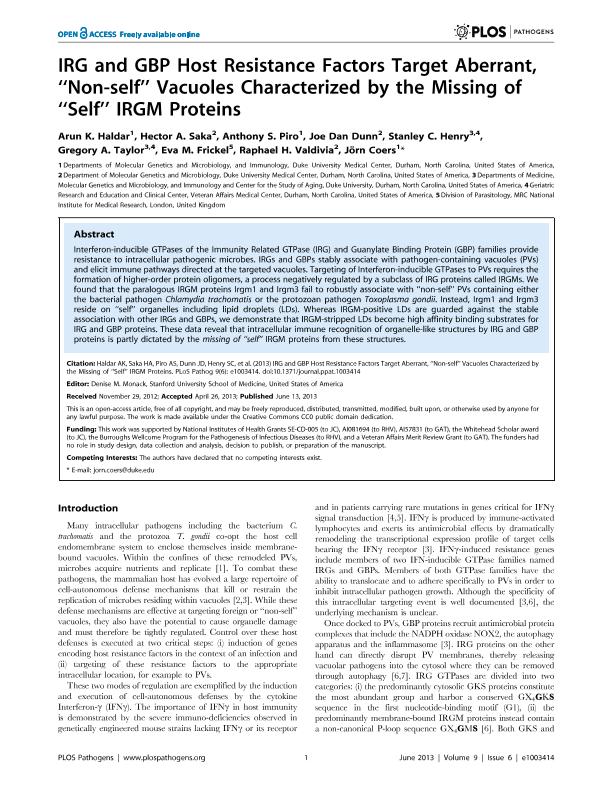Artículo
IRG and GBP host resistance factors target aberrant, ‘‘Non-self’’ vacuoles characterized by the missing of ‘‘Self’’ IRGM proteins
Haldar, Arun K.; Saka, Hector Alex ; Piro, Anthony S.; Dunn, Joe Dan; Henry, Stanley C.; Taylor, Gregory A.; Frickel, Eva M.; Valdivia, Raphael H.; Coers, Jörn
; Piro, Anthony S.; Dunn, Joe Dan; Henry, Stanley C.; Taylor, Gregory A.; Frickel, Eva M.; Valdivia, Raphael H.; Coers, Jörn
 ; Piro, Anthony S.; Dunn, Joe Dan; Henry, Stanley C.; Taylor, Gregory A.; Frickel, Eva M.; Valdivia, Raphael H.; Coers, Jörn
; Piro, Anthony S.; Dunn, Joe Dan; Henry, Stanley C.; Taylor, Gregory A.; Frickel, Eva M.; Valdivia, Raphael H.; Coers, Jörn
Fecha de publicación:
06/2013
Editorial:
Public Library Of Science
Revista:
Plos Pathogens
ISSN:
1553-7366
Idioma:
Inglés
Tipo de recurso:
Artículo publicado
Clasificación temática:
Resumen
Interferon-inducible GTPases of the Immunity Related GTPase (IRG) and Guanylate Binding Protein (GBP) families provide resistance to intracellular pathogenic microbes. IRGs and GBPs stably associate with pathogen-containing vacuoles (PVs) and elicit immune pathways directed at the targeted vacuoles. Targeting of Interferon-inducible GTPases to PVs requires the formation of higher-order protein oligomers, a process negatively regulated by a subclass of IRG proteins called IRGMs. We found that the paralogous IRGM proteins Irgm1 and Irgm3 fail to robustly associate with ‘‘non-self’’ PVs containing either the bacterial pathogen Chlamydia trachomatis or the protozoan pathogen Toxoplasma gondii. Instead, Irgm1 and Irgm3 reside on ‘‘self’’ organelles including lipid droplets (LDs). Whereas IRGM-positive LDs are guarded against the stable association with other IRGs and GBPs, we demonstrate that IRGM-stripped LDs become high affinity binding substrates for IRG and GBP proteins. These data reveal that intracellular immune recognition of organelle-like structures by IRG and GBP proteins is partly dictated by the missing of ‘‘self’’ IRGM proteins from these structures.
Palabras clave:
Irg
,
Gbp
,
Droplets
,
Chlamydia
Archivos asociados
Licencia
Identificadores
Colecciones
Articulos(CCT - CORDOBA)
Articulos de CTRO.CIENTIFICO TECNOL.CONICET - CORDOBA
Articulos de CTRO.CIENTIFICO TECNOL.CONICET - CORDOBA
Citación
Haldar, Arun K.; Saka, Hector Alex; Piro, Anthony S.; Dunn, Joe Dan; Henry, Stanley C.; et al.; IRG and GBP host resistance factors target aberrant, ‘‘Non-self’’ vacuoles characterized by the missing of ‘‘Self’’ IRGM proteins; Public Library Of Science; Plos Pathogens; 9; 6; 6-2013; 1-5
Compartir
Altmétricas



